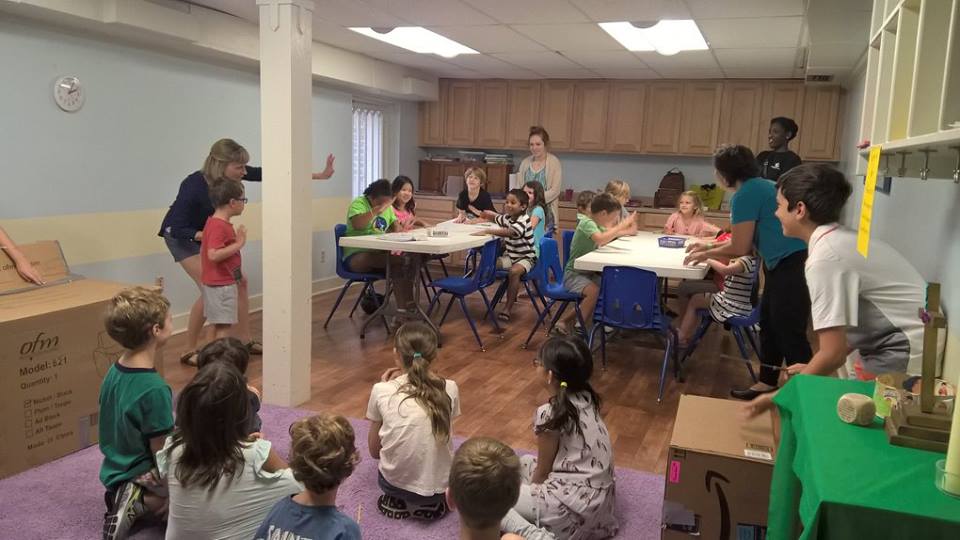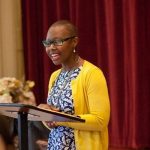Churchwork reflection by Lindsey Ardrey, youth director, St. George’s, New Orleans

[Photograph courtesy of St. George’s, New Orleans] Having fun at Vacation Bible School at St. George’s, New Orleans, in August.
Lately, I’ve fallen in love with the idea that the Old Testament books named after the prophets were written by poets and creatives who used the imagery of language to enliven God’s message. It’s no surprise that I’m drawn to the prophets at a time when our country is screaming out for moral direction. Walter Brueggemann’s idea of prophetic imagination invites us to step into the text and bravely consider parting with our old ways and visualizing new ways of being. Freer ways of being. Ways of being that were once close to us when we were children. So please, if only for a moment, give yourself permission to lose your mind from reasoned and rationalized thought and step into the text with me.
“Our bones are dried up, and our hope is lost; we are cut off completely.” In Ezekiel 37:1-14, the poet vividly unfolds the story of dry bones filling an immense valley. One can imagine bone on top of bone, filling the abysmal and darkened space. God leads the man through the valley and asks, “Can these bones live?” God instructs this Son of Man to prophesy to the bones by saying, “Hear the word of the LORD. Thus says the Lord GOD to these bones: I will cause breath to enter you and you shall live.” The man does as God commands and in response, a distinct noise is heard throughout the valley. It’s the rattling of bones coming together. Bone to bone, flesh on top of sinews, covered with skin. A sight to behold. But the newly formed bodies aren’t yet breathing so God tells the man to prophesy to the breath so that they could truly live. The man prophesies to the four winds and God breathes life into the formerly slain. I bring this text to mind because it can be easy to throw in the towel when it feels like our own bones are dried up and it feels like all hope is lost. When every right action we take seems to be countered by three wrong and worse actions, when our energy has been depleted and even righteous anger has dwindled. I find solace in this passage because God returns to the bones. God hears the cries of God’s people and does not abandon them. Yet it isn’t with the snap of fingers that God awakens the bones. God calls on the human to prophesy. The bodies in the valley were fully formed but they were not yet alive. It was the breath—God’s breath—that brought them to life. Reading
Ezekiel, I know I’ve found the cure for dry bones. Children. Young people are our breath and God calls us to prophesy to them. Children wake us up and rattle our bones out of our daily monotony.
On Sunday mornings, I stand at our classroom door along with the other Sunday School leaders welcoming families with their children before parents whisk themselves upstairs to mass. Just outside of the classrooms, children are asked to provide an offering to God. We aren’t shaking them down for their allowance money, but asking for something perhaps a little costlier. Children reflect on the past week or look towards the upcoming week by offering up a joy, hope, or worry and writing it on a small piece of paper. Once they’ve completed this, their entry into the room is granted and we begin our sacred space time. Inside, we complement this introspection with soft lighting, a comfy seating area with large pillows, and individual contemplative activities. Children can sit at the table and color, thumb through a book we have on hand, or read a book they’ve brought along. Next, we gather around the altar. Lighting a candle, we remind ourselves what the word sacred means and how we embody the concept of a Sabbath day. What symbols mark this space as sacred? How do we know that this day is different? We recall when Jacob woke from his dream and proclaimed, “Surely the LORD is in the place—and I didn’t even know it!” We set an intention, then gather for the lesson. Without explicitly stating it, we underscore the notion that as children of God, they are sacred. If God can inhabit our physical spaces, surely God can dwell within us.
I started incorporating sacred space when I felt that all other measures had failed. We had a behavior problem with one age group and I realized that the children didn’t know what to make of Sunday School. It isn’t quite like regular school, and it’s not as proper as church. It was merely an extension of their weekend. So I decided to throw out the old playbook and to start fresh by emphasizing the reason we gather, knowing that what we do on a consistent basis matters. It matters that we gather together, and it matters that children know they are loved and treated as contributors to our world. Our sacred world—what a concept! A world where Jesus walks on water, turns water to wine, and heals sick people with his bare hands and sometimes only with a word. A world where a young king dances with fervor before the ark, plays musical instruments, and writes poetry. A world where a stuttering man’s staff parts a large body of water. A world where a people habitually grumble, complain, and lose faith yet God continues to call them time and again. Children live in our long-forgotten space of the impossible. Children flirt with the fantastical and journey to worlds adults have rationalized away. For children, there is no impossible. In my first days as youth minister at St. George’s in New Orleans, I worried that I wouldn’t adequately teach them about God but it didn’t take me long to realize that my anxiety was baseless. Children already navigate an
existence that operates on a higher spiritual
realm than the rest of us, and they don’t need adults explaining how God works. I’ve learned that what children and youth need are spaces and opportunities to encounter the Divine. And occasionally, maybe we help them define their language for such encounters. I think that if we do this, we are firmly laying the foundation for a lifelong practice of religious and spiritual curiosity that far exceeds rote church attendance based on blind obligation.
After scanning the news headlines, returning to the organized chaos of children’s and youth ministry is refreshing. I know refreshing isn’t a word often associated with children, but compared with the tumult outside, working with young people seems like a retreat. I’m not turning a blind eye to what’s going on outside the church walls, but acknowledging that our next teachers, priests, healers, entrepreneurs, and public servants will grow from these young ones. We can have the courage to prophesy a world powered on the love that Jesus taught and the justice that God demands alongside of children. We can’t leave children’s ministry to the women, or the school teachers, or the enthusiastic extroverts. Every member of God’s kingdom on earth is commissioned to raise up a generation not ashamed to proclaim the Gospel or divest themselves of moral ambiguity. God has presented children as a gift to renew and strengthen us. When our bones cry out, our hope is within them. Prophesy to the breath.
 St. George’s Episcopal Church in New Orleans was established in 1860. Lindsey Ardrey has served as the youth coordinator since 2014. She also serves as the co-chair of the Racial Reconciliation Commission of the Diocese of Louisiana.
St. George’s Episcopal Church in New Orleans was established in 1860. Lindsey Ardrey has served as the youth coordinator since 2014. She also serves as the co-chair of the Racial Reconciliation Commission of the Diocese of Louisiana.
